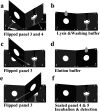Origami-based "Book" shaped three-dimensional electrochemical paper microdevice for sample-to-answer detection of pathogens
- PMID: 35518615
- PMCID: PMC9055359
- DOI: 10.1039/d0ra03833d
Origami-based "Book" shaped three-dimensional electrochemical paper microdevice for sample-to-answer detection of pathogens
Abstract
Herein, an ease-of-use and highly sensitive origami-based "book" shaped three-dimensional electrochemical paper microdevice based on nucleic acid testing (NAT) methodology was developed for sample-to-answer detection of pathogens from whole blood and food samples. The whole steps of NAT, including sample preparation, amplification and detection, were performed by alternately folding the panels of the microdevice, just like flipping a book. The screen-printing electrodes were combined with wax-printing technology to construct a paper-based electrochemical unit to monitor Loop-mediated isothermal amplification (LAMP) reaction with an electrochemical strategy. After nucleic acid extraction and purification with the glass fiber, the LAMP reaction was performed for 45 min to amplify the extracted nucleic acid sequence, followed by the execution of the electrochemical interrogation reaction based on methylene blue (MB) and double-stranded LAMP amplicons. Starting with whole blood and food samples spiked with Salmonella typhimurium, this microdevice was successfully applied to identify pathogens from biological samples with satisfactory sensitivity and specificity. Therefore, the proposed origami-based "book" shaped three-dimensional paper microdevice has great potential for disease diagnosis, food safety analysis applications in the future.
This journal is © The Royal Society of Chemistry.
Conflict of interest statement
There are no conflicts to declare.
Figures






Similar articles
-
Paper-Based All-in-One Origami Microdevice for Nucleic Acid Amplification Testing for Rapid Colorimetric Identification of Live Cells for Point-of-Care Testing.Anal Chem. 2019 Sep 3;91(17):11013-11022. doi: 10.1021/acs.analchem.9b01263. Epub 2019 Jul 18. Anal Chem. 2019. PMID: 31276385
-
Fully integrated and slidable paper-embedded plastic microdevice for point-of-care testing of multiple foodborne pathogens.Biosens Bioelectron. 2019 Jun 15;135:120-128. doi: 10.1016/j.bios.2019.04.011. Epub 2019 Apr 11. Biosens Bioelectron. 2019. PMID: 31004922
-
Fully Integrated and Foldable Microdevice Encapsulated with Agarose for Long-Term Storage Potential for Point-of-Care Testing of Multiplex Foodborne Pathogens.ACS Sens. 2019 Oct 25;4(10):2754-2762. doi: 10.1021/acssensors.9b01299. Epub 2019 Sep 24. ACS Sens. 2019. PMID: 31502446
-
Loop-mediated isothermal amplification (LAMP): A novel rapid detection platform for pathogens.Microb Pathog. 2017 Jun;107:54-61. doi: 10.1016/j.micpath.2017.03.016. Epub 2017 Mar 18. Microb Pathog. 2017. PMID: 28323152 Review.
-
LAMP-on-a-chip: Revising microfluidic platforms for loop-mediated DNA amplification.Trends Analyt Chem. 2019 Apr;113:44-53. doi: 10.1016/j.trac.2019.01.015. Epub 2019 Jan 31. Trends Analyt Chem. 2019. PMID: 32287531 Free PMC article. Review.
Cited by
-
Electroanalytical Paper-Based Nucleic Acid Amplification Biosensors with Integrated Thread Electrodes.Anal Chem. 2021 Oct 26;93(42):14187-14195. doi: 10.1021/acs.analchem.1c02900. Epub 2021 Oct 14. Anal Chem. 2021. PMID: 34648274 Free PMC article.
-
Paper-Based Electrochemical Biosensors for Food Safety Analysis.Biosensors (Basel). 2022 Nov 28;12(12):1088. doi: 10.3390/bios12121088. Biosensors (Basel). 2022. PMID: 36551055 Free PMC article. Review.
-
A Mini Review on Electrochemical Nano-biosensors in Detection of Drugs/Pesticides.Indian J Microbiol. 2025 Mar;65(1):216-234. doi: 10.1007/s12088-024-01303-9. Epub 2024 May 28. Indian J Microbiol. 2025. PMID: 40371039
-
Recent Developments in Paper-Based Sensors with Instrument-Free Signal Readout Technologies (2020-2023).Biosensors (Basel). 2024 Jan 11;14(1):36. doi: 10.3390/bios14010036. Biosensors (Basel). 2024. PMID: 38248413 Free PMC article. Review.
-
Lab-on-Paper Devices for Diagnosis of Human Diseases Using Urine Samples-A Review.Biosensors (Basel). 2021 Aug 3;11(8):260. doi: 10.3390/bios11080260. Biosensors (Basel). 2021. PMID: 34436062 Free PMC article. Review.
References
-
- Havelaar A. H. Kirk M. D. Torgerson P. R. Gibb H. J. Hald T. Lake R. J. Praet N. Bellinger D. C. de Silva N. R. Gargouri N. Speybroeck N. Cawthorne A. Mathers C. Stein C. Angulo F. J. Devleesschauwer B. World Health G. Organization Foodborne Disease Burden Epidemiology Reference. PLoS Med. 2015;12:e1001923. doi: 10.1371/journal.pmed.1001923. - DOI - PMC - PubMed
-
- Tepeli Y. Ülkü A. Sens. Actuators, B. 2018;254:377–384. doi: 10.1016/j.snb.2017.07.126. - DOI
LinkOut - more resources
Full Text Sources
Other Literature Sources
Miscellaneous

